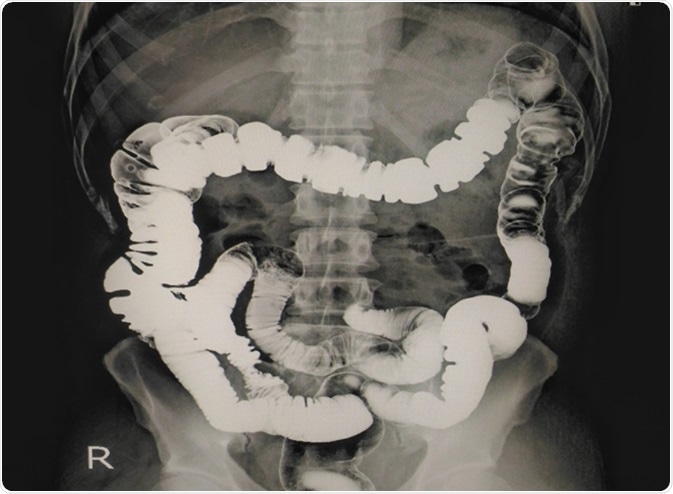Fluoroscopy is a diagnostic scan used to study the movement of body structures. This article describes the medical procedure that takes place during a fluoroscopy.

X-ray Barium enema showing normal colon mucosa. Image Credit: Richman Photo / Shutterstock
What is fluoroscopy?
Fluoroscopy shows a continuous X-ray image on a monitor, much like an X-ray movie. During the procedure, an X-ray beam is continuously passed through the specific body part being examined. The images are transmitted to a monitor to evaluate the organ’s movement.
The doctors can visualize many body parts, such as the digestive, skeletal, respiratory, urinary, and reproductive systems. In some instances, interventional fluoroscopy is performed. It uses ionizing radiation to guide small instruments such as catheters through blood vessels.
It is a promising procedure because it’s less invasive that only requires a small incision. It substantially reduces the risk of infection and can promote a briefer recovery time, compared to conventional surgical procedures.
What is a fluoroscopy?
What are the indications for fluoroscopy?
Fluoroscopy is used in various types of procedures and examinations, including cardiac catheterization, lumbar puncture, arthrography or visualization of joints, barium X-rays, placement of intravenous catheters, biopsies, hysterosalpingogram, and intravenous pyelogram, among others. The other uses of fluoroscopy include locating foreign bodies, injecting image-guided anesthesia into the spine or joints, and in percutaneous vertebroplasty.
What are the risks of fluoroscopy?
Fluoroscopy is generally safe for patients. However, the patient may ask the doctor about the amount of radiation used during the procedure and the risks. The risks linked to radiation can be related to the cumulative number of X-ray examinations or treatments over a long period of time.
For patients undergoing fluoroscopy with a contrast medium, it’s important for the patient to notify the doctor about allergies to the substance or any history of allergic reactions. Patients who are allergic to some medicines, iodine, latex or contrast media are at a greater risk of developing an allergic reaction. Pregnant women are also discouraged from undergoing this procedure since it can harm the fetus.
What to expect during a fluoroscopy procedure?
Fluoroscopy procedures help effectively diagnose a disease or to guide doctors during treatment procedures. Some procedures are performed as outpatient procedures, during which the patient awake and not under general anesthesia. For example, awake fluoroscopy can be used for gastrointestinal series to examine the esophagus, stomach, and small intestine.
Some patients may need to be sedated, particularly those undergoing cardiac catheterization to evaluate heart function and the supply of blood to the heart muscle.
Prior to the procedure, the patient will be asked to remove any jewelry or clothing that may get in the way of the body part being examined. Some patients may need to receive a contrast medium, given intravenously, orally, or rectally (via enema).
During the exam, the patient will be asked to lie on a table. Often, fluoroscopy procedures are painless but can be uncomfortable for some patients.
The patient will be asked to refrain from normal eating or drinking for a time prior to the procedure. Also, in some patients, they may need a bowel preparation to better visualize the bowel or large intestine. Patients will be asked to wear a gown.
The patient will be positioned on the table, depending on which part is to be examined. A special X-ray scanner will be used to create fluoroscopic photos of the body part being examined or treated.
The type of care needed after the procedure depends on the type of procedure performed. For instance, in cardiac catheterization patients, they need more time to recover. They may need to be admitted to the hospital since they need several hours with immobilization of the leg or arm where the catheter was inserted. But, some procedures may need only a short time of recovery.
Fluoroscopy, just like other diagnostic tests, is important in the early detection of diseases or any abnormality. It enables doctors to plan for a treatment regimen that can help address the problem.
Further Reading
Last Updated: Feb 24, 2023